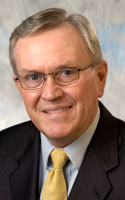  |
| HOME | THIS ISSUE | CALENDAR | GRANTS | BACK ISSUES | < BACK | NEXT > |
President's column
|
||||
|
It’s been quite a summer. For the past several months, the University has come under close scrutiny by some segments of the media, and the Governor’s Commission on UConn Review and Accountability has been conducting a review of the UConn 2000 construction program. This has been a time-consuming and challenging process. But it has also been a wholly legitimate and, I believe, ultimately a healthy exercise. UConn is arguably the most well-known and vital public entity in the state. It is appropriate for the media to examine all aspects of our operation, negative as well as positive. The Governor and General Assembly have a responsibility to see to it that the public’s hopes for us are being realized and that the investment in a 21st-century university is being well managed and accomplishing its broader objectives. Let me reiterate what I said last spring, as this process began. By any fair measure, UConn 2000 is a major success. In the immediate sense, it revitalized a statewide set of campuses that are now a point of pride for students, faculty, and the entire state, and the vast majority of projects have been completed on time, within budget, and without serious problems. More fundamentally, UConn 2000 generated the progress that has characterized this great university over the past 10 years: 6,000 additional students, doubling of freshman applications (nearly 19,000 applications for 3,200 places at Storrs alone), a 70- to 80-point rise in average Storrs SATs, growth in endowment from $47 million to $272 million. While the public may focus on our U.S.News & World Report ranking among the top 30 public universities nationally and unquestionably #1 in New England, here, within the institution, we can see even more clearly the impact of positive momentum: an outstanding faculty, long this university’s greatest single asset, able at last to work to the full measure of excellence, with outstanding facilities and students to match. But associated with the progress there have been some problems. To oversimplify a bit, we can trace the deficiencies to three causes: first, excessive speed generated by the need to accommodate the greater student demand that came with our rising reputation; secondly, a well-intentioned but, in retrospect, perhaps misguided effort to administer a $2.3 billion construction program without significant expansion of administrative staff; and thirdly, an organizational structure that did not incorporate sufficient checks and balances to assure full, impartial oversight of all projects. Long before the media focused on the problems that affected some UConn 2000 projects, we had already taken action to remedy what we identified as weaknesses. In 2003, we established the long-overdue position of vice president and chief operating officer and recruited Linda Flaherty-Goldsmith to fill it. A seasoned administrator, Linda took charge of the building program, noted our progress, and also identified areas in need of strengthening.
Later that year, the Board of Trustees established the Joint Committee on Audit and Compliance and, in close consultation with the Board, the administration expanded and strengthened our internal audit function. Mike Walker, a highly skilled and experienced professional, came to us from Wake Forest in January to lead that operation. More specific measures were being put in place as problems in three residence hall projects came to light beginning last summer. Following consultation with the Board of Trustees and discussions with the Senate Executive Committee, the faculty, the professional staff unions, and other campus groups, we developed and implemented a seven-point corrective action plan that has been outlined in detail in the Advance and elsewhere. Strongly endorsed by the Board of Trustees in June, the implementation of some of those plans assured that all of our residence halls opened this week, with all repairs fully inspected by our Office of Fire Marshal and Building Inspector’s staff and with their safety confirmed by the state Department of Public Safety. Although some additional work needs to be completed next summer, the facilities are up to the students’ level of expectation. Equally important, systems are now in place to help ensure that there will be no recurrence of the problems we encountered. It is possible that more can be done. Gov. Rell’s seven-member Commission on UConn Review and Accountability, charged with independently examining all aspects of the University’s construction program, will issue its report in a few days. As the Governor said, the panel understands that “UConn is a cornerstone in the foundation of Connecticut’s educational, economic, and cultural future.” We expect that the Commission will recognize the steps taken by the University thus far and propose recommendations on how the construction program can be strengthened further. Through the summer, many of us have spent countless hours meeting with the Commission, responding to well-considered questions, and providing voluminous documentation on all aspects of the construction program since the initiation of UConn 2000. I look forward to a useful report. Let me close on a personal note. I would be less than honest if I were to say that this has been an enjoyable period. But I still wouldn’t trade UConn’s position with that of any other public university in the country. It is often said there is no gain without pain. Our recent difficulties, painful though they have been, have not reversed our upward trajectory. Problems have been identified, corrections are being implemented, and we continue to explore ways of strengthening our processes even further. As this summer comes to an end, and as we welcome a new class of outstanding students and a new group of exceptional faculty, we stand ready to begin another successful year.
|
| ADVANCE HOME UCONN HOME |

